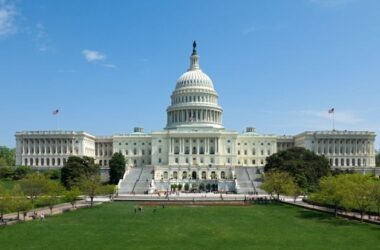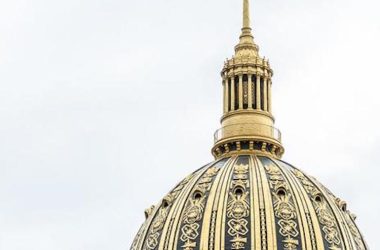By Jim Workman
West Virginia Press Association
CHARLESTON, W.VA. — More than 200 tourism industry representatives gathered at the State Capitol on Monday, advocating for the industry and meeting with Governor Jim Justice and legislative leaders.
While the Capitol’s Rotunda was full of volunteers and tourism displays from around the state, the message from legislative leaders was not as tourism focused: There is only so much money available, and teachers and corrections officers, along with the tourism industry and others, all have needs.
Governor Justice, speaking to a group of tourism leaders, said he will fight to keep the $20 million for West Virginia tourism advertising he placed in the budget, but he urged the tourism officials to meet with their legislators, make their case, and build legislative support for the proposal.
The$20 million figure represents a $14 million increase over 2017.
Tourism officials, wearing “$8 to $1” badges on Monday, point to an estimated $8 to $1 return on investment for tourism advertising. Noting the numbers, Justice said revenue from the $160 million return on the $20 million investment can be used to “bump” teacher salaries and cover PEIA premiums.
“If someone will just think,” Justice said, talking about the legislative support needed to allow the state to generate revenue through tourism.
Delegates Daryl Cowles, R-Morgan, and Paul Espinosa, R-Jefferson, speaking to the tourism officials earlier in the day, said while they understand tourism’s position, not all legislators are convinced West Virginia will realize such a return on advertising spending. Many, they said, want to use the $20 million now in the budget to help teachers, correction officers and PEIA, not count on a later $160 million ROI from tourism.
Monday was Tourism Day at the Legislature. The annual event is designed to raise awareness of the significant economic impact of tourism in West Virginia.

“Today we recognize and celebrate our state’s tourism industry,” Tourism Commissioner Chelsea Ruby said. “Tourism in West Virginia is big business. It supports nearly 45,000 jobs and lessens the tax burdens on hardworking West Virginians. Without the $527 million in state and local taxes generated from this industry, each household in West Virginia would have to pay an additional $700 a year in state and local taxes. This is an industry that benefits us all, and that’s why Governor Justice has recommended we increase the state’s investment.”
Tourism officials said travelers spend just over $4 billion a year in West Virginia, which is equivalent to roughly $11.3 million per day. Research shows that every dollar the state spends on tourism advertising generates $8 in state and local taxes. There is also a halo effect from tourism advertising, documented in a recent study which showed that after seeing a tourism ad, perceptions of West Virginia improved dramatically.
“Tourism advertising improves the state’s image across the board and is a strategic investment for West Virginia,” Ruby said. “When folks are exposed to our advertising, they begin to view the state as more than just a place to visit. West Virginia becomes a sought-after destination – one that is perceived as a good place to live, start a career, start a business, attend college, purchase a vacation home and retire.”
With an advertising effort to promote tourism as an economic driver, West Virginia’s attractions would see a significant bump, officials said, adding that the effort would bring whitewater rafting and snow skiing enthus
But smaller communities and their events stand to benefit from a tourism push as well.
“We benefit from any statewide tourism because we are an entryway,” said Mike Ruben, executive director of the Ripley Convention and Visitor’s Bureau. “We have three hotels right off Interstate 77. When people are traveling from Cleveland, Ohio to go whitewater rafting, they’re going to stop off (at Ripley), grab a meal, get fuel, spend the night. Our two exits are two of the more convenient ones in that whole stretch of I-77.”
Ruben was one of the 200 plus tourism officials at the Tourism Day festivities. The Ripley CVB is looking to attract visitors to its annual events: the Ripley Fourth of July Celebration, the Mountain State Art & Craft Fair and the West Virginia Chocolate Festival.
It’s an exciting time for the tourism industry, Ruben said. “They’re putting more emphasis on tourism, trying to get West Virginia caught up with some of the surrounding states are doing. We will all benefit from it.”
According to the 2017 annual report by the West Virginia Association of Convention & Visitors Bureaus, tourism in Jackson County is responsible for 410 jobs there, as well as $37.3 million in direct spending, $3.05 million in state in local taxes, and $317,000 in local taxes. Ripley is the county seat of Jackson.
Investing in tourism has been a theme of the 2018 legislative session, including Gov. Justice’s State of the State address last month.
It was a 2016 report from Longwoods International that estimated an 8-to-1 return on investment on every dollar spent on tourism advertising. The state yields $8 in state and local tax revenue and $106 in direct traveler spending for every dollar spent on tourism advertising, the report states.
Currently, West Virginia trails surrounding states in traveler spending. Tourism officials contend that it puts the state at a competitive disadvantage.
Additional advertising is key, officials contend.
“The $14 million improvement package the Governor has recommended is going to allow West Virginia to capture some of that market share,” Ruby said. “It’s time to tell the world what a great place we have here.”
Out-of-state residents’ awareness of West Virginia increase dramatically after seeing ads, the Longwoods International study reported.
Ruby addressed the $14 million general revenue improvements requested for tourism during a recent House Finance Committee meeting. Of that money, $2.5 million would go toward marketing, $3 million to brand awareness, $4 million to brand promotion, $1 million to public relations, $2 million to events and sponsorships, $1 million to state parks and recreation advertising and $500,000 to industry development, she reported.



